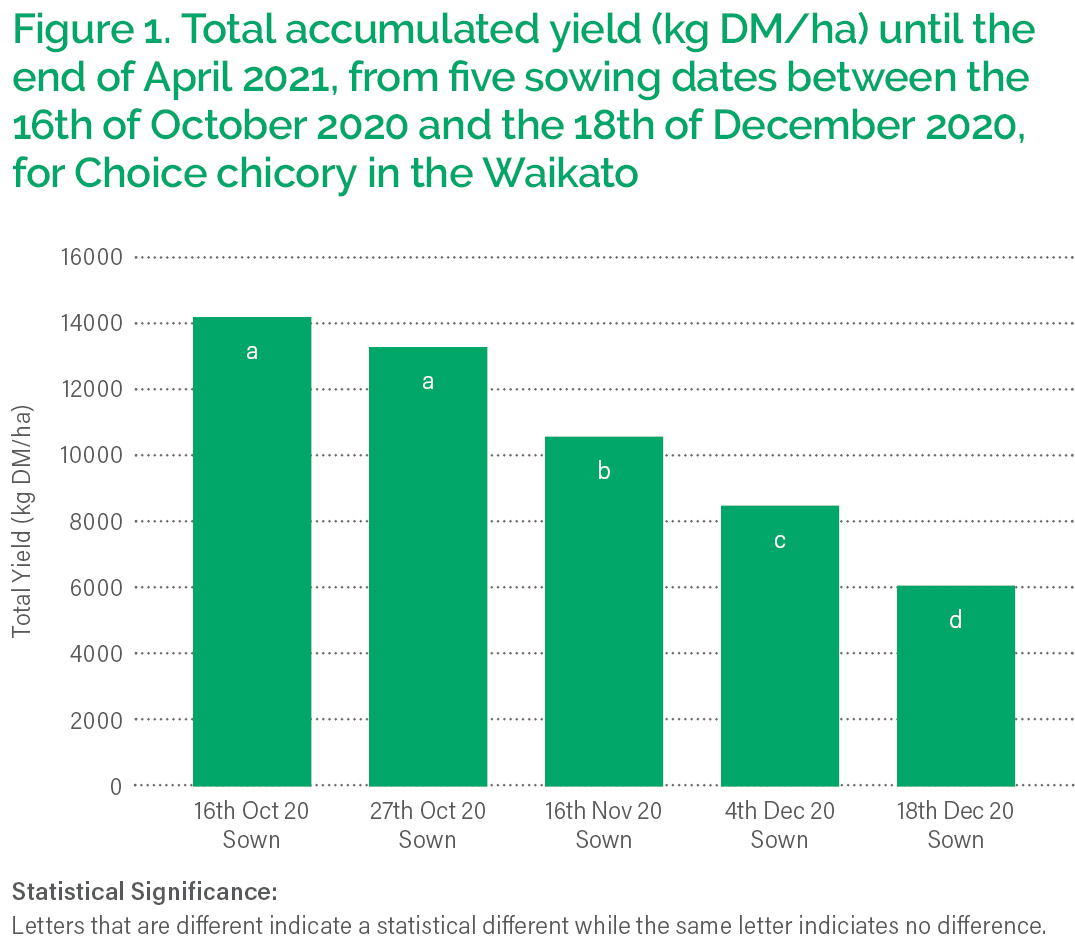Choice
NEW ZEALAND BRED CERTIFIED CHICORY.

- Perenniality Perennial
- Grazing Seasons Spring, Summer
Choice was bred in New Zealand by AgResearch Grasslands, the breeders of the original forage chicory, Grasslands Puna. Choice was bred from true perennial chicory parents under grazing evaluations and selected for high drymatter production, improved cool season growth, disease tolerance and recovery after grazing.
- A long-lived chicory with strong persistence
- Certified chicory variety
- Superior disease tolerance
- Improved drymatter production
- Ideal for short term ‘finishing’ or dairy pastures
Learn more about why Choice is the right decision for your farm on The Al & Juddy Show podcast, or check out more Seed Dating episodes here.

Sowing & Establishment
Sowing date comparison
In addition to running yield trials between cultivars, Agricom has also been looking into other aspects such as different sowing dates of Choice and how this effects the total yield grown (kg DM/ha) to maximise production. Figure 1 shows sowing Choice in October provides the highest drymatter production taken up until end of April.
The key points found from sowing Choice in October:
- Early first grazing (early-mid December) to boost milk production when ryegrass quality is low from seed head development
- Maximises number of grazings; 6-8 grazings from an October sowing versus only 2-3 grazings from a late sowing
The take home message here is aim to sow chicory by mid-October, as there could be up to a 50% loss of yield (kg DM/ha) by planting in December.

Performance Data
Choice is a proven fast-starting variety that is high yielding and a profitable 6-month summer crop. Through our extensive trialling system and on-farm use, our farmers have confidence that Choice is a reliable performer, as shown in Figure 2. Choice was bred from true perennial chicory parents under grazing evaluations (including dairy) and selected for high drymatter production, disease tolerance and recovery after grazing. We have not seen annual type chicories have a statistical yield advantage for first grazing over perennial type chicory, and Choice over many years has met expectations for time to first grazing.
Some other chicory cultivars (spadona’s) are shorter lived by nature due to being susceptible to diseases and plant populations tend to thin drastically, especially in wetter environments. Choice is a longer-lived chicory due to its strong perenniality and disease tolerance, therefore in desired situations with fertile and free draining ground Choice can be used as a two year crop (as shown in Figure 3).

Suggested Mixes
Pure sward
Requires different establishment and management to grass pastures. It is however the most effective way of increasing animal performance as it provides a greater amount of high-quality feed over summer to supplement the animals diet.
| Rate (kg/ha) | |
|---|---|
| Choice chicory | 8-10 |
| TOTAL | 8-10 |
High performance grass/clover mixed pasture
Great option when using short term pastures and wanting to increase animal performance on a pasture based system. Requires very little change to pasture establishment and management. Ideal for run-off’s where growing out young stock or taking off supplement i.e. silage.
| Rate (kg/ha) | |
|---|---|
| Mohaka AR37 tetraploid hybrid ryegrass | 16 |
| Choice chicory | 2 |
| Relish red clover | 5 |
| Attribute red clover | 3 |
| TOTAL | 26 |
Finishing mix
Requires similar establishment and management to a pure sward of chicory but can be more suitable as 18-24 month crop due to the clover content.
| Rate (kg/ha) | |
|---|---|
| Choice chicory | 6 |
| Relish red clover | 4 |
| Attribute white clover | 3 |
| TOTAL | 13 |
Oversown/undersown into pasture
Good establishment can be achieved by spreading seed at 1-3 kg/ha just prior to grazing in spring or undersowing into pasture after grazing. This suits grass pastures planted in autumn without chicory which require thistle spraying in the first winter, or running out/open pastures to fill in gaps.
